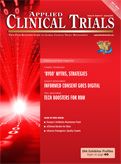EHR eSource: Sword of Change?
Applied Clinical Trials
Recent FDA draft guidance pushes for the use of electronic health record data in clinical investigations-and synching EHRs with research systems.
Now that the era of digital health is upon us in the U.S. and other countries, it’s time for a fresh look at how we collect research data. What if we could make a great leap forward by completely changing our approach through electronic health record (EHR) eSource? Would we dare to try?
“Source” is the initial recording of data for a clinical study. When the original recording is on digital media rather than paper, it’s “eSource.” Clinical trials have used eSource for years in ECG readings, lab results, and other measurements. The FDA eSource Guidance describes different ways to transmit eSource data (from direct capture, devices, transcription, EHRs, or patient-reported outcome instruments) to an electronic case report form (eCRF) system, and several approaches have been proposed for trying to feed EHR data into our existing EDC-based processes. Last year the FDA even asked for demonstration projects to explore such approaches.
But a more recent draft Guidance on Use of EHR Data in Clinical Investigations offers another take entirely with explicit goals to “facilitate the use of EHR data in clinical investigations” and to “promote the interoperability of EHRs” with clinical research systems. The guidance recognizes that the ONC Health IT Certification Program can indicate the readiness of EHRs to support research. And ONC’s Advancing Care Information initiative relies heavily on leveraging application program interfaces (APIs) to make health data more timely and accessible to patients and caregivers.
This is where HL7’s FHIR platform standard comes in:
- FHIR’s Data Access Framework will provide a universal API to EHR systems that can be used to populate much of a casebook in a clinical database.
- The Smart on FHIR specification demonstrates how patients can grant researchers access to their data through electronic informed consent, as well as input outcome data through smartphones and browsers-data that can be directed to an EHR or a trusted third-party cloud-based research repository simply by selecting the appropriate target FHIR server.
- Since EHR data is eSource, FHIR can also provide authorized access to remote study monitors.
- And since FHIR can update as well as read data, it can also support the processing of data clarification transactions, thus making it possible to synchronize EHR records with clinical databases, improving transparency and traceability for both monitors and regulatory inspectors.
- FHIR makes it possible for regulatory reviewers to delve into the full EHR database to explore, for example, serious adverse events, in more depth than was ever possible before.
In the future, it may not be necessary to have an eCRF system in the middle of the process. That would enable using the EHR data directly to feed our analysis so that all health data could potentially be reused as research data.
Wayne Kubick, is Chief Technology Officer, Health Level Seven International, and a member of Applied Clinical Trials’ Editorial Advisory Board

Improving Relationships and Diversifying the Site Selection Process
April 17th 2025In this episode of the Applied Clinical Trials Podcast, Liz Beatty, co-founder and chief strategy officer, Inato, discusses a number of topics around site engagement including community-based sites, the role of technology in improving site/sponsor relationships, how increased operational costs are impacting the industry, and more.
Behind the Buzz: Why Clinical Research Leaders Flock to SCOPE Summit
February 7th 2025In this episode, we meet with Micah Lieberman, Executive Conference Director for SCOPE Summit (Summit for Clinical Ops Executives) at Cambridge Innovation Institute. We will dive deep into the critical role of collaboration within the clinical research ecosystem. How do we bring together diverse stakeholders—sponsors, CROs, clinical trial tech innovators, suppliers, patients, sites, advocacy organizations, investors, and non-profits—to share best practices in trial design, program planning, innovation, and clinical operations? We’ll explore why it’s vital for thought leaders to step beyond their own organizations and learn from others, exchanging ideas that drive advancements in clinical research. Additionally, we’ll discuss the pivotal role of scientific conferences like SCOPE Summit in fostering these essential connections and collaborations, helping shape the future of clinical trials. Join us as we uncover how collective wisdom and cross-industry partnerships are transforming the landscape of clinical research.
FDA-Approved Gene Therapy Beqvez Shows Sustained Efficacy, Safety in Long-Term Hemophilia B Trial
April 17th 2025Beqvez (fidanacogene elaparvovec), an FDA-approved one-time gene therapy for hemophilia B, demonstrated sustained factor IX expression, low bleeding rates, and a favorable safety profile over long-term follow-up.